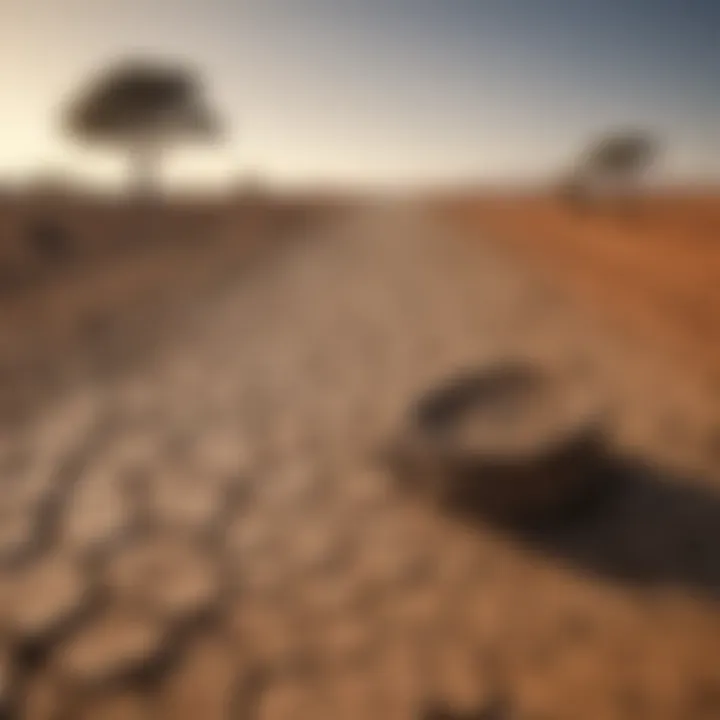Exploring Water Scarcity in Africa: Causes and Impacts


Intro
Water scarcity is a critical problem that affects many regions of Africa. It poses significant risks not only to the environment but also to economic stability and social welfare. Understanding the complex factors that contribute to this issue is essential for addressing it effectively.
The demand for water continues to rise. Population growth, urbanization, and climate change are altering the availability of this vital resource. Some areas experience severe droughts, while others contend with the mismanagement of water resources. These disparities create challenges in achieving equitable water access.
Several studies indicate that nearly 300 million people in Africa face inadequate access to safe water. This statistic is staggering and underscores the urgency for solutions. Addressing water scarcity requires a multi-dimensional approach, considering environmental, economic, and social factors.
As Africa continues to grapple with these pressing challenges, it becomes crucial to evaluate existing initiatives aimed at enhancing water management. Collaboration at local, national, and international levels is necessary to develop sustainable practices. This article presents a comprehensive overview of the multifaceted causes, impacts, and possible solutions to the ongoing water crisis in Africa.
Preamble to Water Scarcity in Africa
Water scarcity in Africa is a critical issue, impacting millions of lives across the continent. Understanding this topic is essential to comprehend the broader implications for health, agriculture, and socioeconomic development.
Every region in Africa faces unique challenges regarding water availability. This makes a comprehensive examination important for developing effective strategies that address diverse situations. Increasing awareness about water scarcity can lead to significant policy shifts and resource allocation that reflect the urgency of the matter.
Definition and Importance of Water Scarcity
Water scarcity refers to the lack of sufficient available water resources to meet the demands of water usage within a region. It can be either physical scarcity, where there is not enough water to meet needs, or economic scarcity, where water is available but not accessible due to inadequate infrastructure and financial resources. In Africa, both types of scarcity are prevalent.
The importance of addressing water scarcity cannot be overstated. It influences public health, food security, and economic stability. Limited water access directly correlates with poor health outcomes. It can lead to malnutrition and outbreaks of diseases. Additionally, agriculture, a significant sector in many African economies, heavily relies on access to clean water. Without adequate water, crop yields decline, affecting food supply and increasing reliance on imports, which can create cycles of poverty.
Contextualizing Water Scarcity within Africa
To contextualize water scarcity in Africa, one must consider the continent's unique geography, climate variations, and historical factors. Africa is characterized by diverse ecosystems, ranging from arid deserts to lush forests. This diversity significantly affects the distribution and management of water resources.
In North Africa, for instance, the Sahara Desert dominates, leading to extreme challenges in accessing fresh water. On the other hand, Sub-Saharan Africa has abundant water bodies, yet mismanagement and political factors result in scarcity in many areas.
Moreover, historical practices and colonial legacies have influenced how water resources are governed today. Many regions still feel the effects of past policies, which are often unsuited for modern challenges. Understanding these historical contexts is vital for implementing effective and sustainable solutions to water scarcity.
"Water is a fundamental resource that reflects the environmental, economic, and social complexities of African nations."
In summary, addressing water scarcity in Africa requires a comprehensive understanding of its many dimensions. It is a pressing issue that necessitates immediate attention from all sectors of society.
Historical Overview of Water Accessibility
Understanding the historical overview of water accessibility is crucial in grasping present challenges faced across Africa. This section elaborates on how past practices and policies lay the groundwork for today's water management systems. Assessing historical contexts offers insights into the systemic issues that contribute to current water scarcity.
Pre-Colonial Water Management Practices
In pre-colonial Africa, water management systems were often developed based on the unique environmental conditions and cultural practices of different societies. These communities employed a variety of techniques to ensure sustainable use of water resources. For instance, many populations practiced traditional irrigation techniques, such as the use of floodplain farming in river basins, which maximized agricultural output during seasonal floods.
Local governance structures typically managed these resources. They set rules regarding access and usage, promoting community cooperation and involvement. For example, in parts of North Africa, communities used qanat systems to transport water efficiently from underground aquifers to fields and settlements. These practices highlighted a deep understanding of local ecosystems and fostered a sense of collective responsibility among users.
However, these systems also faced challenges. Natural variations in climate, such as droughts or floods, could disrupt these traditional practices, leading certain communities to suffer from water shortages. Thus, while pre-colonial methods were innovative and often effective, they were not immune to external pressures.
Impact of Colonial Policies on Water Resources
The advent of colonialism drastically altered water management practices across the continent. Colonial powers often imposed their policies without understanding or respecting existing local systems. This resulted in a shift from community-managed resources to centralized control.
During this period, colonial administrations prioritized water for agricultural and industrial developments primarily to support export economies. This often led to the extraction of water resources from local communities, marginalizing indigenous practices. For instance, in present-day South Africa, the implementation of large-scale irrigation projects disrupted traditional water management, causing conflicts over water rights.
Moreover, the lack of investment in infrastructure for rural communities meant that many people were left without reliable access to safe water. The colonizers typically focused on urban centers, perpetuating inequality in water accessibility. Consequently, today, many regions in Africa suffer from the remnants of these colonial policies, which have left lasting scars on their water governance structures.
Historically, the access to water has been shaped significantly by management practices influenced by both cultural traditions and colonial interventions. Understanding this history is essential in developing strategies to address water scarcity issues faced in Africa today.
Current State of Water Resources in Africa


Understanding the current state of water resources in Africa is vital for addressing water scarcity effectively. This section details how different regions of Africa handle their water availability and highlights the challenges and opportunities present. By examining these factors, stakeholders can formulate strategies that enhance water management and contribute to sustainable development.
Regional Disparities in Water Availability
North Africa
North Africa is characterized by its arid environment and limited water resources. The Sahara Desert dominates the landscape, leading to a reliance on a few major water bodies. The Nile River, one of the longest rivers in the world, is a crucial resource for countries like Egypt and Sudan. However, this dependency also creates tension among these nations regarding water allocation. North Africa showcases how geographical constraints can influence water availability and regional cooperation.
The main benefit of focusing on North Africa is the unique water management practices developed here, such as irrigation techniques. They have adapted to use water efficiently in an environment that does not naturally support extensive agriculture. Despite this, the region faces challenges like drought and pollution, which complicate the situation further.
Sub-Saharan Africa
Sub-Saharan Africa is both diverse and rich in water resources compared to its northern counterpart. Notably, it contains some of the continent’s largest lakes, such as Lake Victoria and Lake Tanganyika. Rivers like the Congo and the Niger provide significant water flow. However, there are stark disparities in access to these resources among different countries.
The key feature here is the vastness of the region and how it affects water accessibility. Some areas are water-rich while others suffer from severe scarcity. This creates a pressing need for equitable water distribution policies. The unique challenge faced in Sub-Saharan Africa is the combination of rapid population growth and inadequate infrastructure, leading to systemic water shortages.
East and Southern Africa
East and Southern Africa presents a mixed picture regarding water resources. The Great Lakes region has abundant fresh water, yet several countries within this area still grapple with water access issues. Countries like Kenya and Tanzania frequently deal with the problems of seasonal rainfall variability, affecting agriculture and daily life.
One of the significant aspects of this region is the presence of seasonal rivers and lakes, which can be a boon but also a curse during drought seasons. Their unique geographical features complicate water management strategies. Communities that depend heavily on these water bodies are often left vulnerable to climate variations, which further exacerbates water scarcity issues in the area.
Groundwater vs. Surface Water Resources
The comparison between groundwater and surface water is key to understanding water resources in Africa. Groundwater wells provide critical supplies for many communities, especially in arid regions. Surface water, while vital for larger-scale agricultural projects, is often more prone to evaporation and pollution. Balancing the use of both resource types is crucial for smarter water management.
Groundwater resources are often considered a buffer against drought, yet over-extraction can lead to long-term depletion.
A concerted effort to manage both types efficiently will play an important role in addressing water scarcity in Africa. Proper studies and resource assessments are necessary for effective solutions.
Causes of Water Scarcity
Understanding the causes of water scarcity is vital for comprehending the full scope of this ongoing crisis in Africa. The interconnection of environmental, social, and political factors intensifies the effects of this phenomenon. Addressing the root causes can aid in developing effective strategies to mitigate the situation.
Climate Change and Environmental Degradation
Climate change has emerged as a significant driver of water scarcity in Africa. Altered rainfall patterns, increased temperatures, and prolonged droughts contribute to diminishing water supplies. As temperatures rise, evaporation rates increase, further reducing the amount of available water. Additionally, shifting weather patterns can lead to excessive flooding in some regions while causing severe droughts in others.
Environmental degradation, which includes deforestation, soil erosion, and loss of biodiversity, exacerbates the water scarcity issue. The destruction of natural habitats and ecosystems disrupts the natural water cycle, leading to reduced groundwater recharge and lower water quality. For instance, when vegetation is removed, the ability of the land to absorb and retain water diminishes, causing runoff and contributing to lower water availability for local communities.
"Climate impacts are expected to be severe in Africa, where many depend on rain-fed agriculture for their livelihoods."
Population Growth and Urbanization
Rapid population growth in Africa compounds the water scarcity problem. The population continues to increase, leading to greater demand for water for domestic, agricultural, and industrial use. Urbanization also plays a critical role. As cities grow, more people migrate from rural areas to urban centers in search of better opportunities. This trend results in increased water consumption, placing tremendous pressure on already limited water supply systems in these urban areas.
The demand for water in urban settings often surpasses supply, creating disparities in accessibility. Many urban residents rely on informal sources for their water needs, which can be contaminated or unreliable. Additionally, poor urban planning and management lead to waste and pollution of available water resources, further worsening the scarcity issue.
Poor Infrastructure and Management Practices
The state of water infrastructure in many African countries requires urgent attention. Aging or inadequate infrastructure hampers efficient water distribution and management. Pipes may leak, and treatment facilities may lack sufficient capacity. This situation often results in significant water loss before it even reaches consumers.
Furthermore, poor management practices hinder responsible water use. Ineffective governance, lack of investment, and insufficient regulatory frameworks can exacerbate inefficiencies. Water resources may be allocated without consideration for long-term sustainability, leading to over-extraction and depletion of vital sources.
Promoting sound management practices through effective policies and investments in infrastructure is essential for addressing the challenges posed by water scarcity.
In summary, the causes of water scarcity in Africa are diverse and interconnected. By understanding these fundamental elements, stakeholders can implement comprehensive solutions to manage water resources sustainably and equitably.
Impacts of Water Scarcity
Understanding the impacts of water scarcity in Africa is crucial for several reasons. It informs policymakers, researchers, and communities about the far-reaching effects that limited water access can have on various aspects of life, including agriculture, health, and the economy. This section will delve into how water scarcity influences food security, public health, and socioeconomic development.
Effects on Agriculture and Food Security


Water is an essential resource for agriculture, which is a critical sector for most African countries. Water scarcity has dire consequences for crop production and livestock management. In many regions, farmers rely on seasonal rains for irrigation. When these rains do not occur, yields decrease significantly, leading to food shortages. For instance, countries like Zimbabwe and Malawi have faced increased production losses because of erratic rainfall patterns.
The consequences extend beyond mere crop failure. Food prices tend to surge due to scarcity, making it difficult for low-income families to afford basic nutrition. Moreover, diminished agricultural output leads to reduced income for farmers, adversely affecting their ability to invest in better farming practices or diversify their crops.
Some statistics underline this issue:
- Approximately 70% of Africa's agricultural water usage is for irrigation.
- Farmers and agricultural workers account for about 60% of the workforce in Sub-Saharan Africa.
Consequently, water scarcity not only threatens food security but also jeopardizes economic stability in regions heavily dependent on agriculture.
Health Implications of Limited Water Access
Limited water access has profound health implications. Clean water is vital for sanitation and hygiene. Contaminated water sources lead to disease outbreaks like cholera and typhoid, further straining health care systems that are often already fragile. Regions with severe water scarcity experience higher rates of morbidity and mortality due to water-related illnesses.
Health disparities become more pronounced as vulnerable populations, such as children and the elderly, suffer disproportionately. Access to clean water correlates directly with child health: malnutrition and stunting are prevalent in areas where water is scarce.
Healthcare costs escalate as communities struggle to cope with waterborne diseases. As people spend significant time fetching water, their productivity decreases, creating a cycle of poverty and poor health outcomes that is hard to escape.
Socioeconomic Consequences
The socioeconomic impacts of water scarcity cannot be overstated. Communities facing water shortages often experience heightened conflict over resources. When water becomes scarce, competition for this vital resource can spur tension between communities, leading to disputes and even violence.
Educational opportunities also diminish in areas where water scarcity prevails. Children, particularly girls, are often tasked with fetching water, thus missing out on school. This perpetuates a cycle of poverty and limits economic growth.
Unemployment rates may increase as businesses face operational challenges due to water availability. Limited supply hampers industries that rely on water, such as agriculture and manufacturing. In some regions, this leads to a significant loss of income and livelihoods.
"Water is life; without it, communities wither, and nations struggle to thrive."
In summary, the impacts of water scarcity in Africa are far-reaching, affecting agriculture, health, and economic stability. Addressing these challenges is imperative for the continent's future.
Mitigation Strategies
Mitigation strategies are crucial for addressing the water scarcity crisis in Africa. These strategies will not only help conserve existing water resources but also promote wise management for future sustainability. With the urgent need to balance rising demand against diminishing supplies, effective mitigation approaches can deliver substantial benefits.
Understanding the importance of mitigation strategies is essential. They contribute significantly to improving water access while minimizing wastage. Moreover, they can help in alleviating environmental stress that has been created by rampant exploitation of water resources.
A thoughtful combination of technological innovations, community engagement, and strong policy frameworks can form a holistic approach to tackle water scarcity.
Technological Innovations in Water Conservation
Technological advancements play a vital role in promoting water conservation. Several innovative solutions have emerged to enhance water use efficiency across various sectors, especially in agriculture and urban areas. Technologies such as drip irrigation, water recycling systems, and rainwater harvesting are becoming increasingly important.
Benefits of these technologies include:
- Reduced water waste through precision irrigation.
- Enhanced capture of rainwater for diverse uses.
- Improved water quality through filtration and treatment systems.
These innovations can significantly alter how societies utilize their water resources, ultimately leading to better water availability. However, technology alone is not a panacea. It requires the support of informed policy and community involvement to be truly effective.
Community Engagement and Education
Involving local communities in water management decisions is key to achieving sustainable practices. Education and awareness programs can empower individuals to understand the importance of water conservation. Community participation can lead to practical solutions that align with local needs.
- Considerations for effective community engagement include:
- Mobilizing local leaders to advocate for water conservation.
- Organizing workshops that teach water-saving techniques.
- Promoting behavioral shifts among community members towards responsible water usage.
By fostering a sense of ownership over water resources, communities can play an active role in developing sustainable practices.


Policy Frameworks and Governance
A robust policy framework is vital for guiding water management initiatives. Effective governance structures can facilitate better resource distribution and allocate funds towards necessary infrastructure improvements. Policies should aim to promote an integrated water resource management approach that considers social, economic, and environmental aspects.
Key aspects of effective policy frameworks include:
- Implementation of regulations that encourage efficient water use.
- Coordination among various levels of government to ensure coherent actions.
- Investment in research to inform policies with scientific evidence.
Effective governance can align individual actions with national objectives, ultimately securing water for future generations.
Case Studies of Successful Water Management
The examination of case studies in successful water management is critical to understanding how various strategies can be implemented to alleviate water scarcity in Africa. Each country faces unique challenges and opportunities based on geographical, political, and economic contexts. By delving into these case studies, the article aims to highlight practical solutions that have already shown effectiveness. These examples serve as a valuable resource for policymakers, environmentalists, and researchers alike. Moreover, they can inspire further innovation and collaboration across the continent.
Lessons from Successful Countries
South Africa
South Africa represents a significant case in water management due to its advanced infrastructure. The country invests a lot in water conservation technologies. A key characteristic of South Africa is its integrated approach to water resource management, which includes public participation and research initiatives. This characteristic makes South Africa a beneficial example for this article. Moreover, its unique feature includes the use of smart water metering systems, which help in reducing waste and promoting efficient usage. However, a disadvantage is that these systems require significant initial investment, which can be a barrier for less developed regions.
Ethiopia
Ethiopia is known for large-scale water projects aimed at irrigation and hydropower development. One specific aspect is the Grand Ethiopian Renaissance Dam that has attracted international attention. The key characteristic of Ethiopia's approach is prioritizing large infrastructure projects to harness water resources. This strategy is beneficial as it addresses multiple needs such as energy production and agricultural irrigation. Nevertheless, a unique feature of Ethiopia's situation is the complexity surrounding cross-border water-sharing agreements, which can create tensions with neighboring countries.
Kenya
Kenya has adopted innovative community-based approaches to water management. The specific aspect of Kenya’s strategy includes water stewardship programs that empower local communities. A key characteristic of Kenya's method is the emphasis on stakeholder engagement, making it a popular choice for this article. The unique feature is the promotion of rainwater harvesting systems at the household level, which has proven advantageous in rural areas. However, the disadvantage is that not all communities can afford the initial setup costs of these systems, highlighting the need for more accessible financing options.
Through these lessons, we see the importance of diverse management approaches in addressing water scarcity across different contexts. Each country's experience offers insightful strategies but also challenges that must be addressed systematically.
Future Directions and Recommendations
Water scarcity in Africa is a complex challenge that demands innovative and multifaceted solutions. The future direction in tackling this issue hinges on proactive strategies that integrate scientific advancements with effective policies. These recommendations are not just desirable but essential for ensuring sustainable water management across the continent.
Integrating Science and Policy
A synergistic relationship between science and policy is paramount in addressing water scarcity. Policymakers must leverage data collected from scientific research to make informed decisions. This can mean utilizing satellite technology and hydrological models to monitor water quality and availability. For instance, deploying remote sensing can help track changes in surface water levels. With accurate data, authorities can formulate policies that are responsive to real-time challenges. Additionally, involving scientists in policy formulation ensures that policies are found on empirical evidence, enhancing the effectiveness of interventions. Ultimately, this integration lays the groundwork for informed strategies that can adapt to the ever-changing environmental conditions impacting water resources.
Sustainable Water Management Practices
Sustainable practices are vital in ensuring the availability of water for future generations. This can be achieved through a combination of conservation efforts, advanced irrigation techniques, and rainwater harvesting. In many African countries, traditional irrigation still consumes significant water resources, leading to wastage. By adopting methods such as drip irrigation or sprinkler systems, water use efficiency can increase greatly. Furthermore, rainwater harvesting systems should be promoted in both urban and rural settings. This not only addresses water shortages during dry seasons but also reduces dependency on surface water sources.
Policy frameworks that align with community values can enhance local participation in sustainable practices. Educating communities on water conservation methods fosters ownership and responsibility towards water resources.
- Key initiatives include:
- Training on water-saving technologies
- Implementing community-based conservation programs
- Enhancing regulation on groundwater extraction to prevent depletion
The intersection of sustainable practices and local knowledge will lead to more resilient water management frameworks. Collaboration between government bodies, NGOs, and local communities can prove effective in ensuring the longevity of water resources.
Effective collaboration in water management not only addresses immediate issues but also strengthens the resilience of communities against future challenges.
End
Water scarcity in Africa is a critical issue that deserves focused attention. This article emphasizes the urgent need to address water scarcity through multiple dimensions, recognizing its impact on agriculture, health, and socioeconomic stability. The integration of science and policy is vital for effective water management strategies. Understanding the historical context of water accessibility assists in better preparing for future challenges. Today, the continent faces unique challenges such as climate change, population growth, and infrastructure deficits.
Key Takeaways
- Interconnectedness of Issues: Water scarcity is not just a singular issue but is deeply connected to climate change, population growth, and urbanization. Each factor reinforces another, amplifying the overall challenge.
- Regional Disparities: Different regions in Africa experience varying levels of water availability. North Africa may face more acute shortages than East Africa, necessitating tailored solutions for each context.
- Importance of Collaboration: No single country or organization can resolve water scarcity alone. Collaboration among governments, NGOs, and local communities increases the potential for effective solutions.
Call for Collaborative Action
Action on water scarcity requires participation from a vast spectrum of stakeholders. Governments should create policies that encourage sustainable water practices. NGOs can facilitate community-driven initiatives centered on water conservation. Private sectors can invest in technologies that improve water access and efficiency. Together, they can foster solutions that prioritize water as a precious resource.
"Water is life, and without it, human progress is severely hindered. Engaging all sectors is necessary to create our water future."







